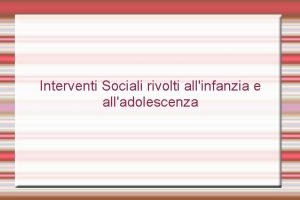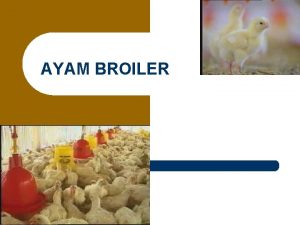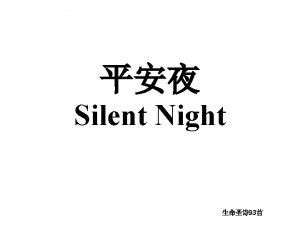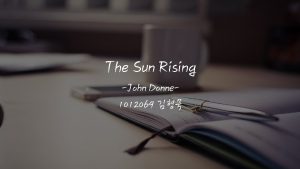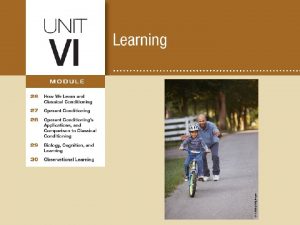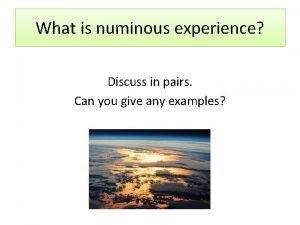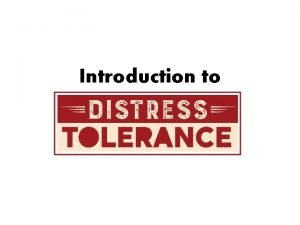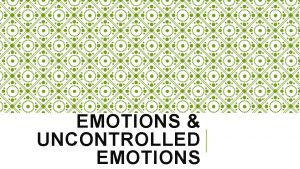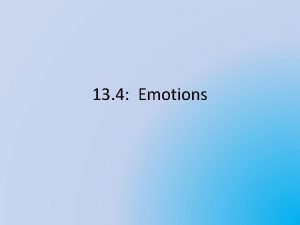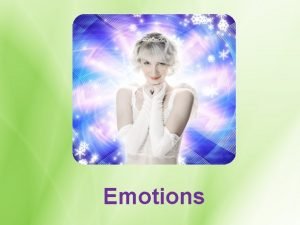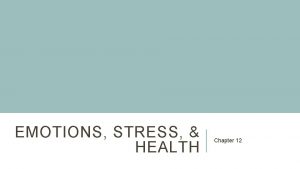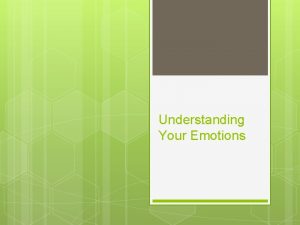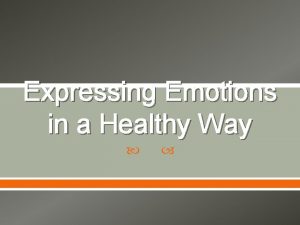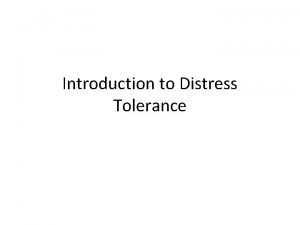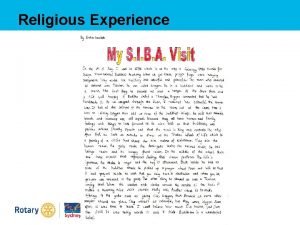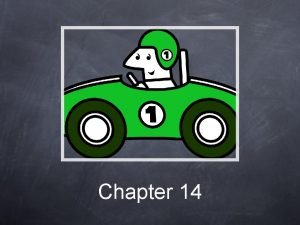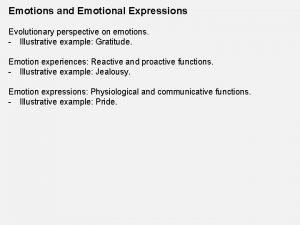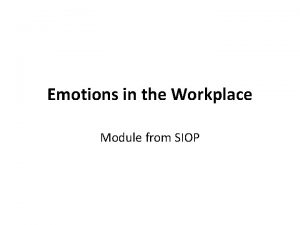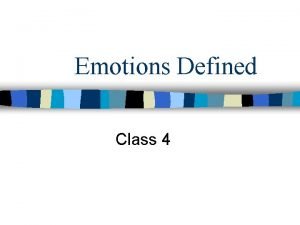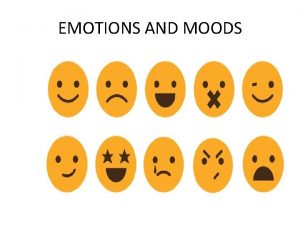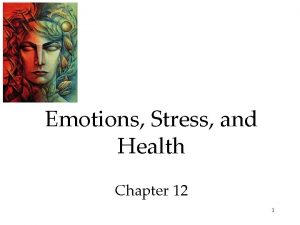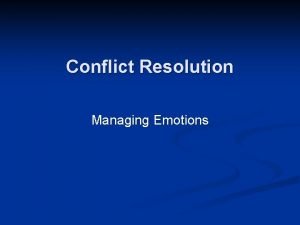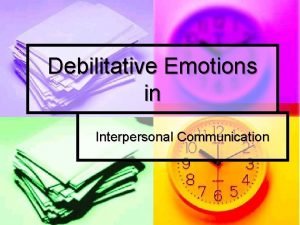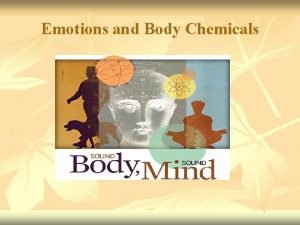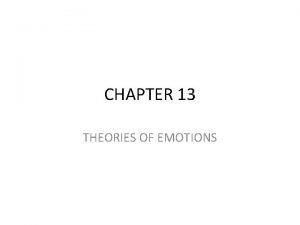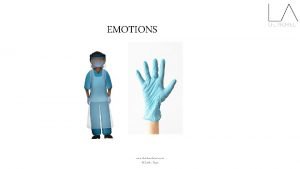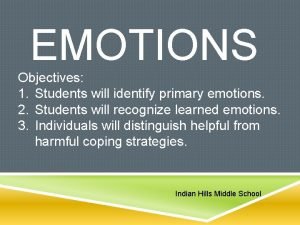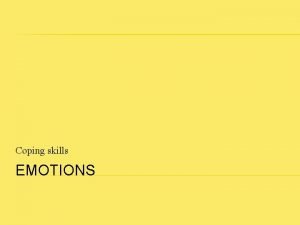Introduction to Emotions We all experience emotions Emotions


























- Slides: 26

Introduction to

Emotions �We all experience emotions. �Emotions are an important part of being human, and are essential to our survival. �As humans we are designed to feel a whole range of emotions, some of which may be comfortable to us, and others may be uncomfortable.

Emotional Discomfort (AKA: Distress) �Most people dislike feeling uncomfortable. �There are many different ways that humans can feel uncomfortable…we can be hot, cold, tired, in pain, hungry, ill, and the list could go on. �The type of discomfort we will be talking about in this lesson is emotional discomfort, or what is often called distress.

What is Distress? �pain or suffering affecting the body, a bodily part, or the mind �"the patient appeared to be in distress"

What is Distress? �a painful situation �"the death of his mother caused him great distress"

What is Distress? �a state of danger or desperate need �"after the car broke down, the passengers were stranded in distress"

�There are varying types of negative emotions that could potentially be distressing for people. �These negative emotions have been categorized into the following 3 clusters: 1) The Sad 2) The Mad 3) The Scared

The Sad � Emotions ◦ ◦ ◦ ◦ ◦ that reflect sadness include: Disappointment Hurt Despair Guilt Shame Sadness Depression Grief misery � These emotions can be thoughts of hopelessness, loss, regret and inadequacy, and the urge to hide away from life.

The Mad �Emotions ◦ ◦ ◦ ◦ that reflect anger include: Irritation agitation frustration disgust jealousy anger rage, hatred �These emotions are usually accompanied by thoughts of unfairness, injustice and wrong doing, and the urge to lash out in some way.

The Scared �Emotions ◦ ◦ ◦ that reflect fear include: Nervousness anxiety dread fear panic terror �These emotions are usually accompanied by thoughts of threat, vulnerability and helplessness, and the urge to avoid or escape.

Think-Pair-Share �We may not like it, but experiencing distress is a natural part of life. �Think of a time when you experienced distress. �Describe how you felt emotionally. �Share with a partner. �Partner A will share with the class what Partner B said.

Important Notice! There are some distressful situations that should not be kept silent and must be reported for the safety of all students. (e. g. , child abuse, suicidal tendencies, etc…)

A vicious cycle �When we feel upset or distressed, we normally react automatically, without thinking about the consequences. �And we can often get into the habit of using unhelpful and often self-destructive behaviors to help us cope. �These may include: ◦ Under or over-eating ◦ Using or relying on drugs and alcohol

A vicious cycle �When we use these self-destructive coping behaviors, we often get caught up thinking we’re bad for doing them, which makes us feel even worse, and may make us more likely to keep on doing them.

Puddle of Water Analogy �Imagine your emotional distress is a puddle of water blocking your path. If you can recognize that emotional distress is not something to be feared, nor something to run away from, then all you have is a puddle of water. If you just wait there it will eventually dry up enough to jump over it, or you could just splash through it and keep on going.

Puddle of Water Analogy Continued However, if instead you fear your distress, struggle with it and try everything to escape from it, all you do is add more and more water to the puddle, and very soon you are faced with a deep pond that is impossible to jump over or splash through. The bigger the pond, the harder to find a way through it, and hence the longer you will feel stuck and unable to move forward.

Practice Distress Tolerance! �In order to break the cycle and avoid a large puddle of water, we can learn to do things differently, including learning new healthy coping skills and learning to understand see our thoughts differently. �It’s not easy or a quick fix – it has to be worked on consistently, and the only certainty is that it takes a lot of practice, practice!

Subjective Units of Distress (SUDS) �As you start to conquer your unpleasant emotions and learn new skills to cope with distress, it becomes very important to have a means of measuring your level of distress. �We will use a SUDS (Subjective Units of Distress) scale ranging from 0 to 10 – a kind of distress thermometer – where 0 is feeling perfectly relaxed and 10 is the worst anxiety and distress you can imagine.

Subjective Units of Distress (SUDS) �It is useful to get into the habit of rating your distress to become more in touch with your emotions and have a better chance of controlling them. �Without some kind of measure, people tend to think in black and white terms – either you are anxious or relaxed – when, in realty, there are many shades of grey. �Using the SUDS scale will help you to keep your distress level in perspective, for example, you may be feeling anxious, but it’s only at level 2 – and you can handle that.

�Now you will work on the Subjective Units of Distress (SUDS) and Distress Tolerance worksheet. �Only complete the matching and questions 1 & 2.

SUDS scale or Thermometer 10 - Highest distress/fear/anxiety/discomfort that you have ever felt 9 - Extremely anxious/distressed 8 - Very anxious/distressed, can’t concentrate 7 - Quite anxious/distressed, interfering with performance 65 - Moderate anxiety/distress, uncomfortable but can continue to perform 43 - Mild anxiety/distress, no interference with performance 2 - Minimal anxiety/distress 1 - Alert and awake, concentrating well 0 - Totally relaxed

Now that you understand distress and know how to measure it, the next step is to learn skills that can help reduce the intensity of your emotions so that you can be more effective.

What is Distress Tolerance? �Distress Tolerance is about getting through a crisis without doing something to make it worse. �In a crisis, emotions are high so the problem is distressing and having high emotions generally makes things worse.

What is Distress Tolerance? �Distress Tolerance skills are used when we are unable, unwilling, or it would be inappropriate to change a situation. �The basic idea is to focus awareness on something other than the hurtful thoughts and emotions.

What is Distress Tolerance? �Distress Tolerance skills are used to help us cope and survive during a crisis, and help us tolerate short term or long term pain (physical or emotional pain).

�Answer question 3 on the worksheet. �Share your response with an elbow partner �Revise or add to your worksheet after your partner work �Turn in worksheet to your Advisory teacher.
 Imprint definition psychology
Imprint definition psychology Early experience vs. later experience
Early experience vs. later experience Direct vs indirect experience
Direct vs indirect experience Name a point that is collinear with the given points
Name a point that is collinear with the given points Introduction to customer experience management
Introduction to customer experience management Introduction to customer experience management
Introduction to customer experience management Help ever hurt never meaning in hindi
Help ever hurt never meaning in hindi Interventi sociali rivolti all'infanzia e all'adolescenza
Interventi sociali rivolti all'infanzia e all'adolescenza Above all powers above all kings
Above all powers above all kings I work all night
I work all night Basic communication operations in parallel computing
Basic communication operations in parallel computing Sistem all in all out
Sistem all in all out Fossa tabatiere
Fossa tabatiere Silent night holy night all is calm all is bright
Silent night holy night all is calm all is bright 馮定華神父2020
馮定華神父2020 All of you is more than enough for all of me
All of you is more than enough for all of me She's all states and all princes i
She's all states and all princes i There in the ground his body lay
There in the ground his body lay Above all powers above all kings
Above all powers above all kings Intro paragraph outline
Intro paragraph outline Work experience chart
Work experience chart Why experience is important
Why experience is important Why do we experience seasons
Why do we experience seasons Partial reinforcement schedule
Partial reinforcement schedule What is a numinous
What is a numinous Maxie schmidt-subramanian
Maxie schmidt-subramanian Vue vip seats
Vue vip seats







